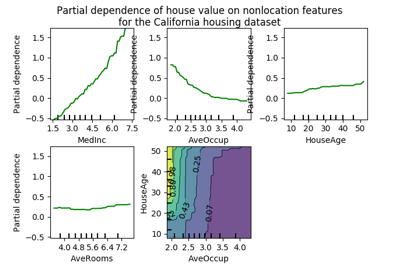sklearn.ensemble.partial_dependence.partial_dependence¶
-
sklearn.ensemble.partial_dependence.partial_dependence(gbrt, target_variables, grid=None, X=None, percentiles=(0.05, 0.95), grid_resolution=100)[source]¶ Partial dependence of
target_variables.Partial dependence plots show the dependence between the joint values of the
target_variablesand the function represented by thegbrt.Read more in the User Guide.
Parameters: - gbrt : BaseGradientBoosting
A fitted gradient boosting model.
- target_variables : array-like, dtype=int
The target features for which the partial dependecy should be computed (size should be smaller than 3 for visual renderings).
- grid : array-like, shape=(n_points, len(target_variables))
The grid of
target_variablesvalues for which the partial dependecy should be evaluated (eithergridorXmust be specified).- X : array-like, shape=(n_samples, n_features)
The data on which
gbrtwas trained. It is used to generate agridfor thetarget_variables. Thegridcomprisesgrid_resolutionequally spaced points between the twopercentiles.- percentiles : (low, high), default=(0.05, 0.95)
The lower and upper percentile used create the extreme values for the
grid. Only ifXis not None.- grid_resolution : int, default=100
The number of equally spaced points on the
grid.
Returns: - pdp : array, shape=(n_classes, n_points)
The partial dependence function evaluated on the
grid. For regression and binary classificationn_classes==1.- axes : seq of ndarray or None
The axes with which the grid has been created or None if the grid has been given.
Examples
>>> samples = [[0, 0, 2], [1, 0, 0]] >>> labels = [0, 1] >>> from sklearn.ensemble import GradientBoostingClassifier >>> gb = GradientBoostingClassifier(random_state=0).fit(samples, labels) >>> kwargs = dict(X=samples, percentiles=(0, 1), grid_resolution=2) >>> partial_dependence(gb, [0], **kwargs) # doctest: +SKIP (array([[-4.52..., 4.52...]]), [array([ 0., 1.])])


